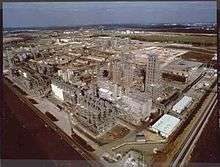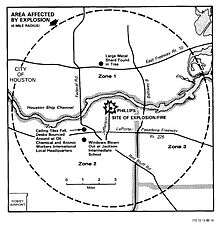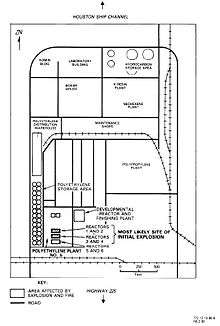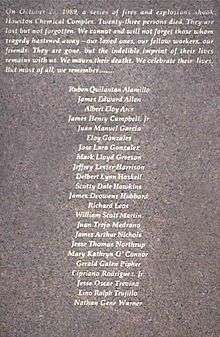Phillips disaster of 1989
The Phillips disaster was a devastating series of explosions and fire on October 23, 1989, near the Houston Ship Channel in Pasadena, Texas, USA. The initial blast registered 3.5 on the Richter scale, and the conflagration took 10 hours to bring under control. Twenty-three employees were killed and 314 injured.
Prior to the disaster

The facility produced approximately 15,000,000,000 pounds (6,800,000 t) per year of high-density polyethylene (HDPE), a plastic material used to make milk bottles and other containers. The Houston Chemical Complex (HCC) facility had 905 company employees and approximately 600 daily contract employees, who were engaged primarily in regular maintenance activities and new plant construction.[1]
Cause
The accident resulted from a release of extremely flammable process gases that occurred during regular maintenance operations on one of the plant's polyethylene reactors. More than 85,000 pounds (39 t) of highly flammable gases were released through an open valve almost instantaneously.
During routine maintenance, isolation valves were closed and compressed air hoses that actuated them physically disconnected as a safety measure. The air connections for opening and closing this valve were identical, and had been improperly reversed when last re-connected. As a result, the valve would have been open when the switch in the control room was in the "valve closed" position. After that, the valve was opened when it was expected to stay closed, and finally passed the reactor content into air.[2]
A vapor cloud formed and traveled rapidly through the polyethylene plant. Within 90 to 120 seconds, the vapor cloud came into contact with an ignition source and exploded with the force of 2.4 tons of TNT.[1] Ten to fifteen minutes later, that was followed by the explosion of the 20,000-U.S.-gallon (76,000 L) isobutane storage tank, then by the catastrophic failure of another polyethylene reactor, and finally by other explosions, probably about six in total.[2]
Explosions


The incident started at approximately 1:05 PM local time on October 23, 1989, at 1400 Jefferson Road, Pasadena, Texas. A massive and devastating explosion and fire ripped through the Phillips 66 Company's Houston Chemical Complex (HCC), killing 23 persons—all working at the facility—and injuring 314 other (185 Phillips 66 employees and 129 contract employees). In addition to the loss of life and injuries, the explosion affected all facilities within the complex, causing $715.5 million worth of damage plus an additional business disruption loss estimated at $700 million. The two polyethylene production plants nearest the source of the blast were destroyed, and in the HCC administration building nearly 0.5 mile away, windows were shattered and bricks ripped out. The initial explosion was equivalent to an earthquake registering 3.5 on the Richter scale and threw debris as far away as six miles.[2]
Early response

The initial response was provided by the Phillips 66 Company fire brigade which was soon joined by members of the Channel Industries Mutual Aid association (CIMA). Cooperating governmental agencies were the Texas Air Control Board, the Harris County Pollution Control Board, the Federal Aviation Administration (FAA), the U.S. Coast Guard, the Occupational Safety and Health Administration (OSHA) and the U.S. Environmental Protection Agency (EPA).[2]
Firefighting
The fire-fighting water system at the HCC was part of the process water system. When the first explosion occurred, some fire hydrants were sheared off at ground level by the blast. The result was inadequate water pressure for fire fighting. The shut-off valves which could have been used to prevent the loss of water from ruptured lines in the plant were out of reach in the burning wreckage. No remotely operated fail-safe isolation valves existed in the combined plant/fire-fighting water system. In addition, the regular-service fire-water pumps were disabled by the fire which destroyed their electrical power cables. Of the three backup diesel-operated fire pumps, one had been taken out of service, and one ran out of fuel in about an hour. Fire-fighting water was brought in by hoses laid to remote sources: settling ponds, a cooling tower, a water main at a neighboring plant, and even the Houston Ship Channel. The fire was brought under control within about 10 hours as a result of the combined efforts of fire brigades from other nearby companies, local fire departments, and the Phillips 66 foam trucks and fire brigade.[2]
Search and rescue
Search and rescue efforts were delayed until the fire and heat subsided and all danger of further explosions had passed. These operations were difficult because of the extensive devastation in the HCC and the danger of structural collapse. The Phillips 66 Company requested, and the FAA approved and implemented, a 1-mile no-fly zone around the plant to prevent engine vibration and/or helicopter rotor downwash from dislodging any of the wreckage. The U.S. Coast Guard and Port of Houston fire boats evacuated to safety over 100 trapped people across the Houston Ship Channel. OSHA preserved evidence for evaluation regarding the cause of the catastrophe.[2]
List of fatalities


Phillips employees
- Fatally wounded, listed by name, age, city of residence within Texas,[3][4] and official date of death (following recovery and identification of remains or eventual death from injuries)[5]
- Stephen Donald Huff, 21, 25 October 1989
- Ruben Quilantan Alamillo, 35, Houston, 25 October 1989
- James Edward Allen, 38, Pasadena, 2 November 1989
- Albert Elroy Arce, 35, Deer Park, 28 October 1989 (listed[6] as Eloy Albert Arce)
- James Henry Campbell, Jr., 30, Baytown, 26 October 1989
- Eloy Gonzales, 36, Houston, 1 November 1989
- Mark Lloyd Greeson, 30, Pasadena, 28 October 1989
- Jeffrey Lester Harrison, 36, Houston, 24 October 1989
- Delbert Lynn Haskell, 43, Deer Park, 29 October 1989
- Scotty Dale Hawkins, 32, Houston, 28 October 1989
- James Deowens Hubbard, 45, Houston, 25 October 1989 (listed[7] as James Hubbard, Jr.)
- Richard Leos, 30, La Porte, 29 October 1989
- James Arthur Nichols, 40, Baytown, 27 October 1989
- Jesse Thomas Northrup, 43, Brookshire, 28 October 1989
- Mary Kathryn O'Connor, 34, Houston, 29 October 1989
- Gerald Galen Pipher, 39, Deer Park, 30 October 1989
- Cipriano Rodriguez, Jr., 42, Pasadena, 27 October 1989
- Jesse Oscar Trevino, 33, Pearland, 30 October 1989
- Lino Ralph Trujillo, 39, Pasadena, 29 October 1989
- Nathan Gene Warner, 30, Deer Park, 24 October 1989
Fish Engineering employees
- Juan Manuel Garcia, 30 October 1989
- Jose Lara Gonzalez, 23 October 1989
- William Scott Martin, 25 October 1989
- John Medrano, 30 October 1989 (listed[8] as Juan Trejo-Medrano)
A granite memorial at 29°43′59.4″N 95°10′57″W / 29.733167°N 95.18250°W near 924 Jefferson Road, Pasadena, Texas was dedicated on the first anniversary of the disaster, and was declared by company officials to be open to the general public at all times.[4]
OSHA findings
OSHA's major findings included: Lack of process hazard analysis; inadequate standard operating procedures (SOPs); non-fail-safe block valve; inadequate maintenance permitting system; inadequate lockout/tagout procedures; lack of combustible gas detection and alarm system; presence of ignition sources; inadequate ventilation systems for nearby buildings; fire protection system not maintained in an adequate state of readiness. Additional factors found by OSHA included: Proximity of high-occupancy structures (control rooms) to hazardous operations; inadequate separation between buildings; crowded process equipment; insufficient separation between the reactors and the control room for emergency shutdown procedures.[2]
Quoting from a key OSHA document:[9]
"At the conclusion of the investigation (April 19, 1990), OSHA issued 566 willful and 9 serious violations with a combined total proposed penalty of $5,666,200 to Phillips 66 Company and 181 willful and 12 serious violations with a combined total proposed penalty of $729,600 to Fish Engineering and Construction, Inc., a maintenance contractor on the site."
OSHA citations
As a result of a settlement between OSHA and Phillips 66 Company, OSHA agreed to delete the willful characterization of the citations and Phillips 66 agreed to pay a $4 million fine and to institute process safety management procedures at HCC and the company's sister facilities at Sweeny, Texas; Borger, Texas; and Woods Cross, Utah.[2]
Facility today
Today, the facility continues to manufacture high-density polyethylene (HDPE), as well as K-Resin SBC.[10] This complex employs 750 workers for the production of specialty chemicals, including 150 operations and maintenance personnel.[11]
The facility experienced additional fatalities in 1999 and 2000. A massive propane leak occurred on June 25, 2008 in a utility easement just outside plant property.[12][13] [14]
See also
References
- 1 2 "OSHA: Phillips 66 Company Houston Chemical Complex Explosion and Fire: A Report to the President, U.S. Dept. of Labor, Washington, DC (1990)" (PDF). Retrieved 2007-12-04.
- 1 2 3 4 5 6 7 8 "Explosion and Fire at the Phillips Company - Houston Chemical Complex" (PDF). Retrieved 2007-12-04.
- ↑ "Death toll now 5, missing Phillips workers". The Daily Pasadena Citizen (Pasadena, Texas: PCL Publishing Company). 1989-10-26. ISSN 0896-3320.
- 1 2 3 "Looking forward, thinking back". The Daily Pasadena Citizen (Pasadena, Texas: PCL Publishing Company). 1990-10-23. ISSN 0896-3320.
- 1 2 Mahaffey, Chuck H. (2001-08-25). "Vital Records - Harris County, TX - Deaths 1989 (root folder)". Texas Department of Health. USGenWeb Archives. Retrieved 2008-06-23.
- ↑ Mahaffey, Chuck H. (2001-08-25). "Vital Records - Harris County, TX - Deaths 1989 (Acosta through Berleth)". Texas Department of Health. USGenWeb Archives. Retrieved 2008-06-23.
- ↑ Mahaffey, Chuck H. (2001-08-25). "Vital Records - Harris County, TX - Deaths 1989 (Hernandez through Johnson)". Texas Department of Health. USGenWeb Archives. Retrieved 2008-06-23.
- ↑ Mahaffey, Chuck H. (2001-08-25). "Vital Records - Harris County, TX - Deaths 1989 (Stancil through Vardaman)". Texas Department of Health. USGenWeb Archives. Retrieved 2008-06-23.
- ↑ "02/12/1991 - Investigation conducted by OSHA at the Houston Chemical Complex". Archived from the original on 2010-11-21. Retrieved 2007-12-06.
- ↑ "Chevron Phillips Chemical Company LLC - Worldwide Operations (hotlink sequence: Polyethylene, Texas, Pasadena)". Retrieved 2008-02-22.
- ↑ "Docket H054A, EX. 50-1-2-24, 24.0 Chromium Catalyst Users, page 24-5 (5 of 20)". Retrieved 2008-02-22.
- ↑ "Pasadena propane pipeline springs a leak". khou.com (KHOU-TV, Inc.). 2008-06-25. Archived from the original on 2008-07-10. Retrieved 2008-06-25.
- ↑ "Accident sparks propane leak near plant". ktrk.com (KTRK-TV/DT). 2008-06-25. Retrieved 2008-06-25.
- ↑ "Propane Leaks From Pasadena Pipeline". click2houston.com (KPRC-TV/DT). 2008-06-25. Retrieved 2008-06-25.
| ||||||||||||||||||||||||||||||
